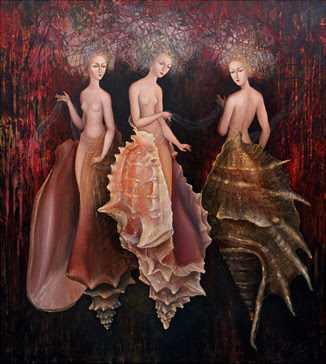Labels such as fantastic art, visionary art, magic realism art, psychedelic art and dark surreal art are applied to categorize the surreal artists of the present day, who were highly influenced by the original group of the Surrealist Movement.
I will present the usual assortment of the contemporaries but for a bit, I have a brief history of Dada (the root movement) and Surrealism.
I will present the usual assortment of the contemporaries but for a bit, I have a brief history of Dada (the root movement) and Surrealism.
The Surrealist movement, founded by writer and poet Andre Breton, was established in the early 20's. It was born out of the World War I movement of Dada. Literature, poetry, art theater and art theory were all connected around manifestos and radical political and social thinking, including anarchy.
Abstract art, sound poetry and performance artists today own and often homage to to Dada. The dadaists rejected conventional social thought and aesthetics, preferring to shock and offend people; all in an effort to liberate the proletariat from the clutches of the capitalist, fascist state.
 Later, Salvador Dali stated:
Later, Salvador Dali stated: "There is only one difference between a madman and me. I am not mad."
His assertion was, in fact, confirmed by Sigmund Freud, another famous founding father whose ideas contributed greatly to the social, intellectual and artistic circles of the time.
The Surrealists were attracted to Freud's ideas because one of their goals was to channel the unconscious as a means to unlock the power of the imagination.
Dali met Freud in London in 1938. At that meeting, Dali showed Freud his 1937 work Metamorfosis de Narciso. Freud was not found of the Surrealist movement but made an exception where Dali was concerned. The work of Joseph Cornell (1903–1972) and Arshile Gorky (1904–1948) was to be heavily influenced by the Surrealist and was a sort of bridge between surrealism and abstract expressionism.
"Up to now I have been inclined to consider surrealists, who seem to have chosen me as their patron saint, as incurable nutcases. The young Spaniard, however, with his candid, fanatical eyes and unquestionable technical skill has made me reconsider my opinion. In fact, it would be very interesting to investigate the way in which such a painting has been composed."
- Sigmund Freud
Dada
 |
| Hannah Hoch |
 |
| Andre Breton, author of the Surrealist Manifesto |
"Living and ceasing to live that are imaginary solutions. Existence is elsewhere.''
Selected Works of Contemporary Art, influenced by Surrealism
(I've attempted to provide attribution and links to the artist site whenever possible)
 |
| Ronald Companoa |


























